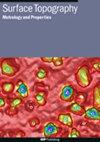作为预处理的激光冲击强化对沉淀硬化不锈钢离子渗氮的影响
IF 2
3区 材料科学
Q2 ENGINEERING, MECHANICAL
引用次数: 0
摘要
激光冲击强化(LSP)正在成为提高工程产品疲劳寿命的先进技术。此外,它还能提高耐磨性和耐腐蚀性,为材料性能带来额外的好处。本研究系统地了解了 LSP 与离子氮化(又称等离子氮化(PN))相结合的混合表面处理方法,以提高沉淀硬化(PH)不锈钢的有效表面硬化层。研究了激光光斑直径、叠加层数和重叠率等输入参数对性能特征的影响,包括表面形貌、显微硬度和拟议处理后显微结构的变化。表面表征结果表明,80% 的激光重叠率改变了 PN 样品的表面粗糙度,原因是在 LSP 处理过程中烧蚀引起了更高的表面粗糙度值。显微硬度和光学显微镜(OM)结果表明,重叠率为 40% 时,由于没有盲点,有效硬化层厚度增加了约 115%。此外,XRD 分析显示 PN 样品表面存在 Fe4N 和 CrN 化合物。扫描电子显微镜(SEM)与能量色散光谱(EDS)元素图谱显示,由于 LSP 预处理的晶粒细化作用,有效硬化层中存在富氮相并增加了有效硬化层厚度。本文章由计算机程序翻译,如有差异,请以英文原文为准。
Effect of laser shock peening as a pretreatment on ion nitriding of precipitation hardened stainless steel
Laser shock peening (LSP) is emerging as an advanced technology to improve the fatigue life of engineering products. Also, this can improve wear and corrosion resistance as add-on benefits to the properties of the materials. In the present investigation, a systematic understanding of the hybrid surface treatment that combines LSP with ion nitriding, also known as plasma nitriding (PN) of precipitated hardened (PH) stainless steel was conducted to improve the effective case hardening layer. The effect of input parameters such as laser spot diameter, the number of superimposed layers, and overlap rate was investigated on the performance characteristics, which include surface morphology, microhardness, and the change in microstructure after the proposed treatment. The surface characterization results reveal that an 80% laser overlap rate modified the surface roughness of PN samples owing to higher surface roughness values induced by ablation during the LSP treatment. The microhardness and optical microscopy (OM) results revealed an increase in the effective hardening layer thickness of about 115% for a 40% overlap rate owing to the absence of blind spots. In addition, XRD analysis revealed the presence of Fe4N and CrN compounds on the surface of the PN samples. Scanning electron microscopy (SEM) with energy dispersive spectroscopy (EDS) elemental mapping reveals the presence of a nitrogen-rich phase in the effective hardened layer and increased effective hardened layer thickness owing to grain refinement of LSP pre-processing.
求助全文
通过发布文献求助,成功后即可免费获取论文全文。
去求助
来源期刊

Surface Topography: Metrology and Properties
Materials Science-Materials Chemistry
CiteScore
4.10
自引率
22.20%
发文量
183
期刊介绍:
An international forum for academics, industrialists and engineers to publish the latest research in surface topography measurement and characterisation, instrumentation development and the properties of surfaces.
 求助内容:
求助内容: 应助结果提醒方式:
应助结果提醒方式:


